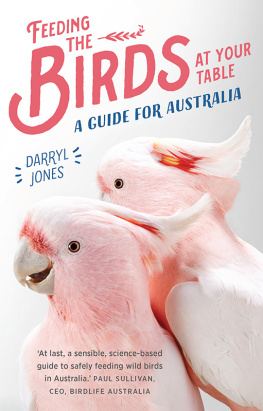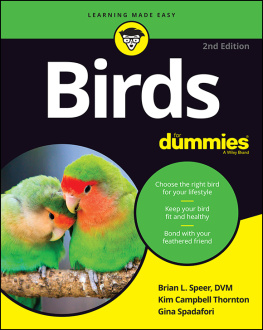

DARRYL JONES is a Professor of Ecology at Griffith University in Brisbane, where for over 30 years he has been investigating the many ways that people and wildlife interact. He is particularly interested in why some species are extremely successful in urban landscapes while many others are not, and how best to deal with the ensuing conflicts. More recently he has been trying to understand more about the humans that also live in cities in large numbers, and how and why they engage with nature. This has led him into the strange and fascinating world of wild bird feeding and has resulted in collaborations with other researchers all over the world. He has published more than 170 scientific papers and six books, including The Birds at My Table (2018).
DEDICATION
For Danielle Hodgson and Cara Parsons.
The best learning and teaching happens in both directions.

A GUIDE FOR AUSTRALIA
DARRYL JONES

A NewSouth book
Published by
NewSouth Publishing
University of New South Wales Press Ltd
University of New South Wales
Sydney NSW 2052
AUSTRALIA
newsouthpublishing.com
Darryl Jones 2019
First published 2019
This book is copyright. Apart from any fair dealing for the purpose of private study, research, criticism or review, as permitted under the Copyright Act , no part of this book may be reproduced by any process without written permission. Inquiries should be addressed to the publisher.

A catalogue record for this book is available from the National Library of Australia
ISBN 9781742236322 (paperback)
9781742244594 (ebook)
9781742249087 (ePDF)
Design Josephine Pajor-Markus
Cover design Madeleine Kane
Cover image Major Mitchells cockatoos, Leila Jeffreys, www.leilajeffreys.com
Illustrations Michelle Baker, www.michellebaker.org
All reasonable efforts were taken to obtain permission to use copyright material reproduced in this book, but in some cases copyright could not be traced. The author welcomes information in this regard.

CONTENTS
FIRST

WHY WE NEED TO TALK ABOUT BIRD FEEDING
Why would we possibly need a guide to feeding wild birds in Australia? Surely everyone knows that we shouldnt be doing it in the first place. We have all seen the DO NOT FEED THE WILDLIFE signs at the local pond or on the picnic tables in national parks. For decades this has been the message endlessly repeated by the RSPCA, wildlife carers, vets, zoos, city councils, state agencies, bird societies and conservation and environment groups feeding wild animals is bad, irresponsible and sometimes even dangerous. These anti-feeding messages are typically accompanied by alarming claims. Wildlife will become dependent on human-provided foods. Animals will forget how to forage naturally and will suffer as a result of their inadequate diet. Feeding wildlife assists the spread of disease and attracts vermin and predators. For anyone who cares about our wildlife, these are confronting issues.
Serious, obviously, but its important to appreciate that feeding wildlife takes two very different forms, and each of these poses different challenges. The signposts and most strident warnings relate mainly to the feeding of wildlife in public spaces. We have probably all witnessed or even directly experienced the behaviour of wild animals that have been given food by humans, and then expect more of it: overly familiar possums or kangaroos at camping grounds; pushy ducks and swans at urban ponds; kamikaze kookaburras joining the barbecue; or the increasingly in-your-face ibis of city parklands. There are some genuinely troubling problems associated with feeding wildlife, and there is clear scientific evidence that some of the birds and other animals in these settings are suffering as a result of being fed too much bad food. Think of the waterbirds consuming all that bread at the duck pond, and the gulls that seem to subsist primarily on chips. We certainly do need to think seriously about whether we should be feeding wildlife in public places, and this is something I will be discussing in chapters 2 and 4. (Spoiler alert: feeding bread to ducks, and chips to gulls, is never a good idea!)
FOR THE MILLIONS OF AUSTRALIANS WHO REGULARLY FEED WILD BIRDS AT THEIR HOMES, THE PRACTICE CAN BE CALMING, HEALING AND INSTRUCTIVE, OFFERING A CHANCE TO CONNECT WITH NATURE.

However, the primary focus of this book is the type of wildlife feeding that we do at home in our backyard, or on our verandah or balcony. I will be concentrating almost entirely on birds although there is plenty of possum, bluetongue, wallaby and even echidna feeding going on as well (we know even less about the effects of feeding on these other types of animals than we do about birds). For the millions of Australians who feed wild birds at their homes (and this includes me), this is almost always something they do regularly, often at the same time every day. It is planned, systematic and organised. The food we provide to our feathered visitors has typically been purchased specifically for that purpose, and the aim is to attract these wonderful and completely wild birds to our homes. If the birds take up the offer, these visits can bring real pleasure and meaning to our lives. For many people, this simple activity is profoundly important; it can be calming, healing and instructive, representing a simple opportunity to connect with nature something that is becoming increasingly hard to do as cities grow and biodiversity retreats.
Obviously, not everyone feeding birds would describe the experience in these terms. But numerous studies from Australia and elsewhere have found that most feeders (the people providing the food, not the feeding platform) look forward to observing their visitors on a regular basis. They also care about these birds and hope that what they are providing is good for them. For many feeders, this is a legitimate worry. Sure, birds eat just about everything that is put out for them. But that does not mean the food is necessarily safe and nutritious. After all, we humans also eat plenty of food that is terrible for us, and we know what happens as a result.
What many people who feed birds have been trying to find and what I am seeking to provide here is reliable information and advice on what they should be feeding their birds, and what they should be avoiding. Most dedicated feeders are quite aware of the well-known concerns referred to above, but simply dont know where to find the advice they need.
A search of the internet will reinforce the conclusion that feeding birds in Australia is wrong and possibly illegal something I am trying to address in this book. The majority of Australian sources amplify the message that feeding leads directly to appalling diseases, dependence on human food (followed inevitably by starvation) and outbreaks of rodents, along with other catastrophes which probably only adds to the confusion and concern of those of us who are feeding birds. These are all possible outcomes, but they are not a given if we follow certain feeding principles and take a strategic and considered approach.
Next page



















